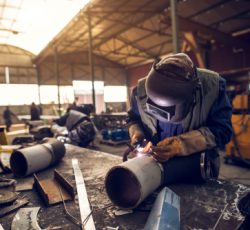 What Do I Need To Know About Metal Fabrication?
What Do I Need To Know About Metal Fabrication?
Metal fabrication is a process that involves cutting, shaping, and assembling metal parts to create products and structures. It’s a crucial part of many industries, including construction, manufacturing, and engineering. Metal fabrication can involve a range of metals, including steel, copper, aluminum, and brass. If you’re planning to work with metal fabricators for your project, here’s what you need to know about metal fabrication.
Types of Metal Fabrication Techniques
There are several metal fabrication techniques that are widely used. They include:
1. Cutting: This involves using a saw, laser, plasma cutter, or water jet to cut metal sheets into specific shapes.
2. Shaping: This process involves heating and bending metal sheets into the desired shape using tools such as hammers, presses, and rollers.
3. Welding: This technique joins two metal pieces by melting them together using heat. Welding is widely used in metal fabrication, and there are several types, including MIG, TIG, and stick welding.
4. Machining: This method is used to remove material from metal parts using various cutting tools such as lathes, drills, and milling machines.
5. Forming: This refers to the processes that manipulate the shape of metal by compressing or stretching it. It includes methods like rolling, forging, and extruding.
6. Assembly: This involves combining different metal parts to create a finished product.
Metal Fabrication Materials
The type of material used in metal fabrication depends on the desired properties of the final product. Some of the most commonly used materials include:
1. Steel: Steel is a popular material due to its strength, durability, and versatility. It’s used to make a wide range of products, from machines to buildings.
2. Aluminum: This material is lightweight, corrosion-resistant, and ideal for making products that need to be durable and sturdy.
3. Copper: Copper is an excellent conductor of electricity, making it ideal for electrical applications. It’s also used in plumbing and roofing.
4. Brass: Brass is a copper-zinc alloy that has a brass-like appearance. It’s commonly used in decorative applications, such as ornamental hardware, musical instruments, and door handles.
Advantages of Metal Fabrication
There are several advantages to using metal fabrication for your project. Some of these benefits include:
1. Durability: Metal products are known for their strength and stability. They can withstand harsh weather conditions, significant wear and tear, and are resistant to corrosion.
2. Customization: With metal fabrication, it’s easy to create customized products that meet your specific needs. You can tailor the size, shape, and design to suit your requirements.
3. Fast Production Time: Metal fabrication is a quick process, so it’s easy to produce large quantities of metal products in a short period.
4. Cost-Effective: Metal is abundant and easy to recycle, making it a cost-effective material.
5. Aesthetically Pleasing: Metal can be shaped into intricate designs, adding a unique visual appeal to your project.
Considerations for Metal Fabrication
When working with metal fabricators, there are several things you need to consider to ensure that your project runs smoothly. These include:
1. Material Selection: Choose the right metal for your project to ensure that it meets your needs and expectations.
2. Timeframe: Determine the time required to complete the project, and ensure that it aligns with your desired completion date.
3. Budget: Discuss the costs of metal fabrication with the fabricator to ensure that you are working within your budget.
4. Risk Assessment: Be aware of potential challenges during the process and have contingency plans in place to mitigate any risks.
5. Quality Control: Ensure that the fabricator has a quality control process in place to guarantee that the final product meets your expectations and requirements.
Choosing a Metal Fabricator
Choosing the right metal fabricator is essential to the success of your project. Follow these tips to find the right fabricator for your needs:
1. Experience: Look for a fabricator with a reputation for quality workmanship and has years of experience working on projects similar to yours.
2. Capabilities: Choose a fabricator with the ability to handle the size and scope of your project.
3. Customization: Choose a fabricator who has the skills and expertise to tailor their process to meet your specific requirements.
4. Communication: Look for a fabricator who communicates well and keeps you informed throughout the entire project.
5. Project Management: Choose a fabricator who has a project management system in place and can deliver a quality product within your timeframe and budget.
Conclusion
Metal fabrication is an essential process used to create several products and structures across various industries. Understanding different fabrication techniques, materials, and considerations will help you choose the right fabricator and ensure the success of your project. With the right team of fabricators, you can create durable, customized, and visually appealing products that meet your needs and aligns with your budget and timeline.
